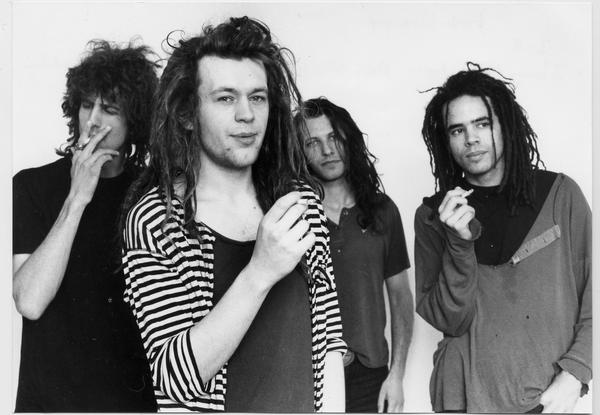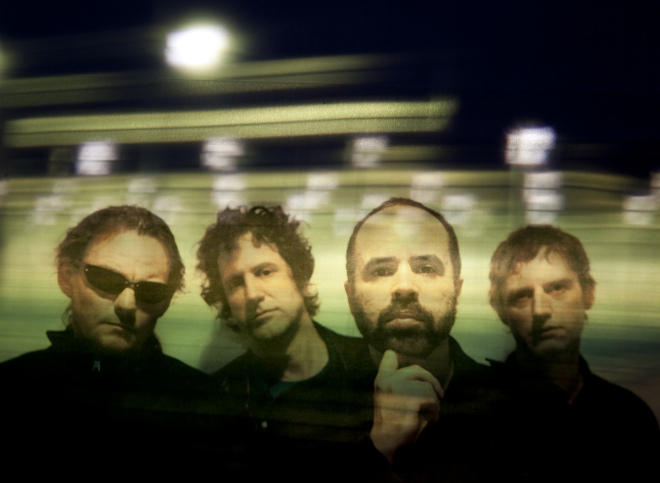NEVER LOSE THAT FEELING – SWERVEDRIVER Live @ Neumos [Seattle]
A review of reunited British quartet, Swervedriver live in Seattle and a look into the genre of shoegaze in general
SWERVEDRIVER
Neumos
Seattle, Wa
4/4/2012
I developed a soft spot for shoegaze music as a freshman in college, when I would hunker down in my room during the harsh winter months in Wisconsin, put on my headphones, and blast myself fifteen years (or more) into the recent, yet pre-digital hegemony, pre-Cobain, pre-Tupac v. Biggie and, therefore, oddly foreign past of popular music. I was a latecomer to shoegaze, six years old when Loveless (My Bloody Valentine) was released — which, as the rock scribes have documented, signified the apex and unequivocal swan song of shoegaze — and was appropriately unaware of it for the subsequent decade of my life. So as a young man interested in The Guitar, and having exhausted my teenage earnings and earnestness underwriting the golden years of rock’s pantheon (as typified by the now-iconic style of CD sticker: “35th Anniversary Edition! Includes exclusive bonus track argument between Rogers and Gilmour regarding unreleased concept album about two guitars that fall in love with each other!“), I was set up to fall hard for shoegaze.
Unlike participating in a current music scene, music wasn’t just part of the equation in my love affair with shoegaze; it was the whole equation. In those frigid winter months, huddled in my dorm room, it seemed entirely appropriate to put on something as icy and swirling as the weather outside. I dug in deep, and got to know Ride, Lush, the Cocteau Twins, Jesus and Mary Chain, Slowdive, Chapterhouse, Swervedriver and the Boo Radleys in this kind of insular atmosphere. While there was some abstract awareness of My Bloody Valentine among my social circle, the entire genre of shoegaze seemed unfamiliar and/or stodgy to my friends. Simply put, it wasn’t music I listened to to feel a sense of community. It was music I listened to because I liked it.
I was intrigued by the challenge, though. The paradox between shoegaze’s relative recentness and its then-current obscurity fascinated me. It was as though the collective memory of my generation had a blank spot where early 90s British music should be–Unlike, say, the way that the mythology of grunge nihilism vanquishing the excesses of hair metal at the end of the Reagan era has still found its way into the cultural memory of Generation Y. No, this was different. It would be easy to assume that the disconnect had to do with the British-ness of shoegaze, although the music that would eventually supplant it as the dominant force in British rock music, Britpop, hasn’t suffered from the same obscurity among Americans. Many an Oasis tune has found its way into that apotheosis of popular music, the campfire sing-along.
During that year or so, when I first discovered shoegaze, I exhausted the genre. Like anyone for whom the world of music has just recently opened, I moved on to other things quickly. But I still retained my interest in shoegaze. So, when I saw that Swervedriver had a Seattle date on their reunion tour, I knew I had to be there.

Defining the sound of shoegaze is itself a very tricky task, and Swervedriver‘s music typifies the genre-bending associated with shoegaze. It’s guitar-centric music, minus the hard rock histrionics of its predecessors. It’s loud, often with scorching riffs, but somehow, introspective. Much of the sound has to do with the production aspect of the recordings, in which the guitars and vocals are mixed to provide texture rather than a focal point. Because of this focus on subtle aesthetic choices, many of the most popular shoegaze bands could also be described as dream pop, grunge, or that vague early 90s catch-all term, alternative rock.
Swervedriver struggled with the “shoegaze” tag as well, arriving on the scene with their excellent debut album, Raise, just as shoegaze’s defining work, My Bloody Valentine‘s Loveless, was released in 1991. Like many other bands from the quasi-shoegaze scene, Swervedriver produced a string of albums in the mid-90s that garnered critical acclaim, but failed to sell. If you listen closely, you can hear the guitars getting crunchier and the reverb drying up from album-to-album, as the shoegaze sound came under commercial assault on both sides of the Atlantic by both Britpop and Grunge.
Given that environment, it’s not difficult to trace the career paths of several top bands who suddenly found themselves without record labels. Swervedriver was no exception, getting dropped by Creation in 1995 and by Geffen a year later. Their final album, 99th Dream, was finally released in 1998 by a small US label, and the group disbanded soon after. After a ten-year hiatus, the band reunited in 2008 for a world tour, the centerpiece of which was a slot at Coachella, making this Swervedriver‘s second reunion tour.
The show at Neumos began with a cacophonous rendition of “Last Train to Satansville,” from Swervedriver‘s second album, Mezcal Head, and continued through “Scrawl and Scream,” “Never Lose That Feeling,” and “Pile Up” with scant pause in between. At one point, frontman Adam Franklin briefly addressed the crowd, but the music continued after a few requisite words. The mood for the concert didn’t call for a lot of stage banter. Instead, walls of distorted guitars, pounding drums, and throbbing basslines reverberated throughout the venue. The band sounded tight and full, as though they were picking up right where they left off. Their main set ended with the riff-heavy “Son of Mustang Ford” and “Rave Down,” a personal favorite of mine from Raise. The rhythmic transitions in this song are striking and drummer, Mikey Jones handled them with ease, despite looking, as someone in the crowd remarked, like a burned-out Ron Jeremy.
About halfway through their set, my friend remarked to me that we were probably the youngest people at the show. This was undoubtedly true. The reunion tour of an early 90s shoegaze band didn’t exactly bring out the teenyboppers. As I stood there, sipping beer with graying marketing types with earplugs, I thought of the span of time that separated us. In, perhaps, no other arena is the passage of time more amplified than in popular music. Between the band’s heyday and now, a lot had happened on the rock scene. Kurt Cobain briefly became the voice of a generation and subsequently killed himself, but not before making the most abrasive, unconventional music that could still attain wide commercial success. The clown princes of Britpop, the Gallagher brothers, set new records for the amount of public dysfunction a successful band can endure. Hip-hop made its biggest impact yet on rock music, in these years, manifesting itself in music as diverse as Radiohead and the ill-conceived rap-metal fad of the early millennium. Simply put, rock music has grown by leaps and bounds since Swervedriver was recording. To my ears, rock music made wholly without danceable rhythms or electronic instruments now seems downright quaint. It’s unfair to criticize a reunited band for failing to incorporate trends that supplanted them, and I won’t do that. But I will say that, before the Swervedriver show, I hadn’t realized how much the larger music scene had shaped my expectations, even those I had for older music.
That night, standing in a Seattle club, I pictured myself in twenty years, having a rare night out, watching some reunited band from my youth cut loose with a couple of old pals. Who would I be watching? It’s impossible to know. As I was pondering this, Swervedriver took the stage for an encore. It was flawless throughout, a performance by professionals who watch the music scene change around them and yet, stuck to their guns. At that moment, it didn’t seem far-fetched that it could be Swervedriver who I would be seeing twenty years from now, the same thundering beats and muscular guitar riffs sending me home with ringing in my ears once again.

It was completely unnecessary for you to be disrespectful about the drummer, in my opinion. And has rock music really “grown by leaps and bounds” since 1998? The fact the you even reference rap-metal illustrates a point. Other than that, all power to the Swerve!